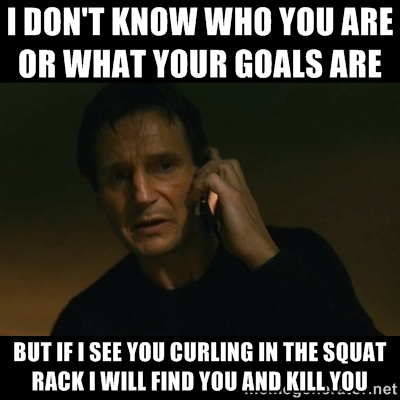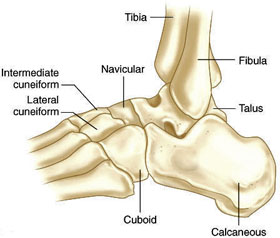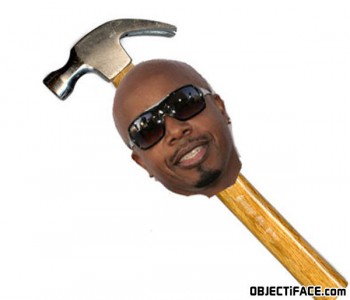Squatting is making a comeback in a BIG way.
You don’t hear as much of the,
“Squatting destroys your knees, back, shoulders, etc”
that you used to.
And the squat racks at my gym are actually, predominantly, used for……wait for it…..wait for it…….
Squatting
Not curls.
Which I think is:
- Awesome.
- Primarily the result of the influence and popularity CrossFit has gained.
Fact is, before CrossFit was everywhere and everyone was hugging Rich Fronings nuts, which are probably 100% jacked.
The rack was an empty, lonely, wonderful place reserved only for those with intestinal fortitude, pride and self-respect knowledge about how to train and actually get something out of it.
Now it’s a free for all.
Everybody is doing Front Squats, Overhead Squats, Goblet Squats and Squat-Squats.
I refuse to call them “Back Squats”, nobody said that nonsense until about 2 years ago….of course they’re “back” squats that’s the default position. You “squat” with a bar on your back, it’s when you do other things with the bar that we have to preface what type of squat it is.
And one of the great things about the squat is that it’s not only a great strength exercise it also doubles as an awesome movement screen.
There is a reason Gray Cook included it in the FMS battery:
Got the pick from: http://www.functionalmovement.com/
You can tell A LOT about someones restrictions and default patterns, strengths and weaknesses simply by watching them squat, especially when they become challenged.
“Everyone looks good when the weight is light”- Dave Tate
For many the challenge may simply be achieving a parallel or below parallel squat. For others it’s maintaining position when they have a load applied.
Either way, when challenged the “problems” come to the surface in a big way.
One of the most glaring, but least treated, of these problems is restricted ankles.
Restricted ankle ROM can cause any number of issues when squatting including:
- Inability to get as deep as possible
- Feet “rolling” in causing the knees to valgus collapse
- Heels coming up
- Inability to get full glute involvement
- Stress on the soft tissues of the knees, especially the meniscus and lateral ligaments
A restricted ankle squat usually looks like this:
Look for weight moving to the balls of the feet and/ or feet/ heels rolling in putting pressure on the inside of the foot.
This is typically seen as weak glutes, and that usual that has something to do with it too, but many times simply “releasing” the ankles will allow the articulation (where the bones meet) of the shin (Tibia/ Fibula) and foot (Talus/ Calcaneus) to rotate, flex and extend properly.
Taken from: http://www.goudelis.gr
When the ankles regain motion the foot can easily remain flat on the floor allowing the lifter to better manipulate foot pressure and providing a stable platform to drive off of.
This will allow the rhythm of the ankle, knee, hip complex to re-establish its self which will allow for better muscle activation patterns (glute/ hamstring involvement) and joint loading (even pressures across the Tibial Plateau minimizing Tibial shear and rotary forces) which should always results in safer, stronger lifting.
Soft Tissue Work:
This is often overlooked when it comes to the ankles but if the tissue surrounding the ankle is a knotty, gunky mess, it’s going to result in restrictions. <—–This point is especially true if you’re someone who wears abhorrent footwear high top/ high cushion shoes or high heels frequently.
Plantar Fascia Rolling:
Calf Rolling:
Anterior Tibialis:
Achilles Rolling:
Movement Training:
Once the tissue is “untacked” we can actually introduce movement into the joint again with the hope that it’ll result in lasting change.
Restoring Ankle Rotation:
Key Points:
- Ankle, knee AND hip MUST be flexed.
- Keep most of your pressure in the heel, but keep the foot flat.
- Think about rotating the shin over the foot.
Restoring Ankle Flexion:
Key Points:
- Don’t “collapse” at the end.
- ONLY flex the ankle, keep the heel down and the hips in line.
Restoring Overall Ankle Dexterity and Motion:
Key Points:
- Try to get into ALL the “corners”. If it’s too easy it’s not working
- Aim for large amplitude movements here, try to make BIG letters and motions.
Test-Retest Paradigm:
None of this matters if we don’t actually get a change in the tissues.
And the fact is the change, at first, is going to be short-lived, but that doesn’t matter.
We’re ONLY looking for change….
At first.
After you do some of these drills re-test your squat.
Look and feel for areas that are moving better, with fewer restrictions. If it works, do those same drills some more and re-test again looking for more improvement.
Yes, the tissue will “rebound” and you’ll be restricted again.
It took a long time to become locked up, it’s gonna take some time to unlock the tissues and make the change back to optimal the permanent, default, state.
Once you find the drills and strategies that work best for you…
Hammer Them
The more frequent the exposures the faster change will become (semi) permanent.
When it comes to mobility work it’s almost always more effective to have multiple, shorter sessions throughout the day rather than one long session.
Kelly Kills it Again:






